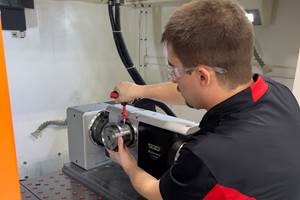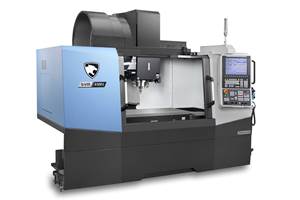New England Moldmaker Does It The Hard Way
This mold and die shop owner had a decision to make: build more capacity, or examine ways to make more finished molds out of existing capacity, save one new machine. He chose the latter.
New England Mold (Sterling, Massachusetts) specializes in deep multi-cavity precision molds, using innovative approaches to automatic unscrewing molds, side-action and cam-actuated molds, and hot runner molds. Typical customers include medical, cap and closure, cosmetic, and automotive, and as often as not, New England Mold is in the loop from part design through prototyping and into production. And, as the company’s reputation attracts new customers, its current list of customers is constantly coming up with new products and new packaging designs, keeping both New England Mold plants busy 24 hours per day. Being so occupied led Jeffrey Barhoff, New England’s president, to have to make a decision: build more capacity, or examine ways to make more finished molds out of existing capacity, save one new machine. He chose the latter.
“We knew we had to be prepared for change,” he says, “but we wanted whatever we did to complement our electrode and wire EDM work coupled with surface grinding. We also knew that a super high-speed milling approach could take us directly to steel as well as cut electrodes.”
After careful consideration, Mr. Barhoff decided to go with the FMC Vibra-Free vertical machining center from Compumachine Inc. (Wilmington, Massachusetts). It is fairly similar to a small handful of other high-speed verticals that are changing mold and diemaking strategies through the adoption of hard milling techniques and elimination of manufacturing steps. The Vibra-Free’s rigid and thermally stable castings support a custom-Swiss-built IBAG high-frequency spindle capable of 42,000 rpm mounted on a bridge-type column above a 26.65 inch by 17.72 inch table. The machine is controlled by an advanced Fanuc 16i-MA CNC incorporating NURBS programming and high-speed algorithms for look-aheads.
The machine has had positive effects so far, according to Mr. Barhoff. One example is a complex mold with many round features that is destined to produce surgical suite pipette trays. “We cut this out of steel in the same time it would have taken to cut the graphite electrode,” he says.
In fact, the machine had work from the very beginning, tackling a variety of SS 48/50 Rc and S-7 54/50 Rc jobs as well as some electrode work. On the jobs in steel, Mr. Barhoff conservatively guesses New England Mold saved 50 percent of that particular portion of “the build” by simply taking the electrode step out of the picture, and allows that as far as electrodes are concerned, “you have to relearn how to cut them, and you have to be set up for it.” The molds went straight to the Brown & Sharpe Gage 2000 CMM and indicated within 0.0002 inch of specification, well within tolerance. And while many claim that the very small light cuts typical of HSM often eliminate the need for polishing, Mr. Barhoff is less enthused, probably because of the mirror-like finishes required of his molds. However, he does note that “I’d rather polish a milled surface than one that’s been burned.”
Mr. Barhoff says another area requiring study in HSM is the economics of the tooling. The tiny SKI 25 carbide coated tools (the cutter and toolholder fit in the palm of the hand) are not inexpensive—the toolholder is, of course, balanced—and their life and cost must be factored in when going straight to hard steel. A critical factor to tool life is often length to diameter, variable by speeds, feeds, and of course, materials.
Typically, though, hard materials in the range of RC40 are attacked with 1.0 mm to 1.5 mm carbide coated ballnose end mills turning between 30,000 and 40,000 rpm and fed at between 90 and 100 ipm. Graphite, on the other hand, is nominally machined with flat end mills, when possible, often with larger diameters, and speeds in the 25,000 rpm range and feeds of about 50 to 60 ipm. MMS
Related Content
What to Do When Five-Axis Machining Is Off the Table
For Fischer USA, 3+2 machining with a high-precision rotary table adds flexibility without the cost of a full five-axis machine.
Read MoreWatchmaking: A Machinist’s View
Old-world craftsmanship combines with precision machining on a vertical machining center and Swiss-type lathe to produce some of the only U.S.-made mechanical wristwatch movements.
Read MorePositioned to Prevail: Designing Processes Around People
Stecker Machine Company shows that getting the most value from employees means valuing your employees.
Read MoreDN Solutions Introduces High-Productivity Vertical Machining Center
The SVM 5100L’s performance has been optimized to reduce the acceleration/deceleration times of the XYZ axes and spindle, reducing non-cutting time.
Read MoreRead Next
3 Mistakes That Cause CNC Programs to Fail
Despite enhancements to manufacturing technology, there are still issues today that can cause programs to fail. These failures can cause lost time, scrapped parts, damaged machines and even injured operators.
Read MoreThe Cut Scene: The Finer Details of Large-Format Machining
Small details and features can have an outsized impact on large parts, such as Barbco’s collapsible utility drill head.
Read More

























